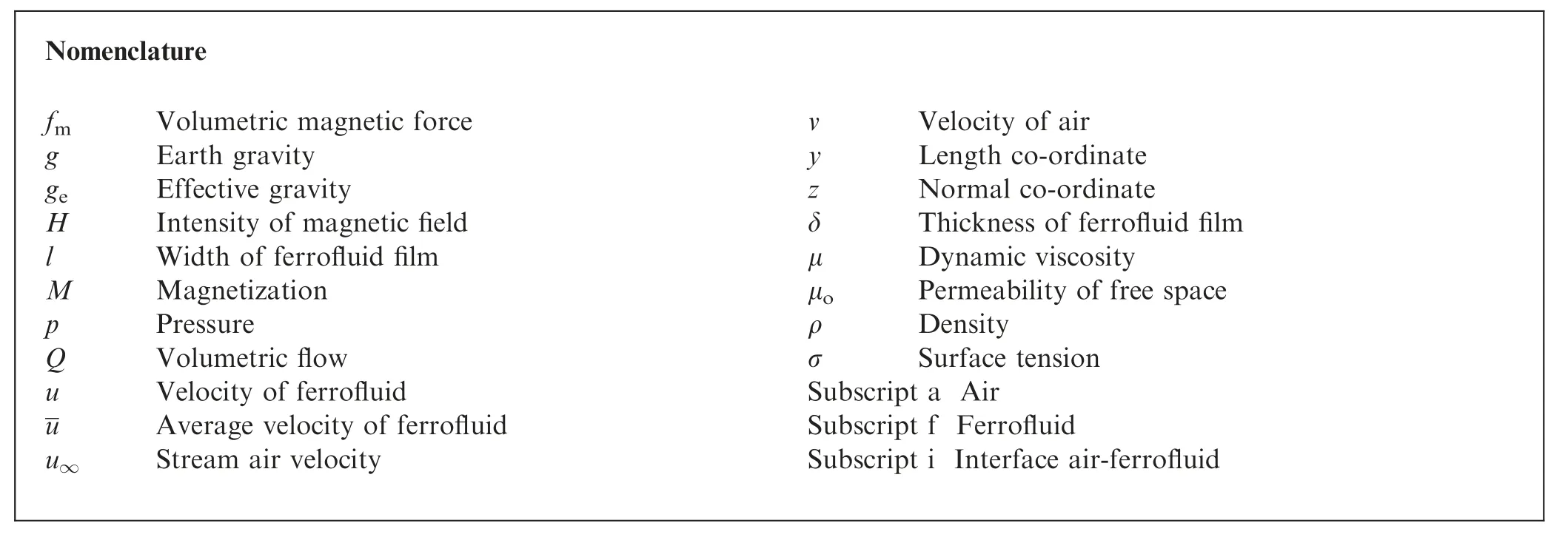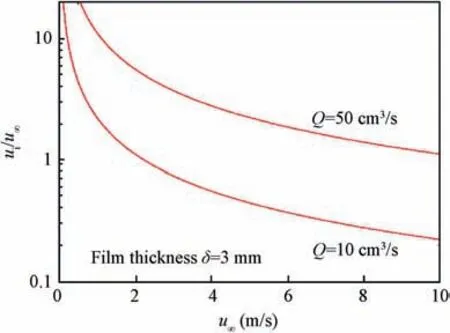Ferrofluid moving thin films for active flow control
Department of Fluid Mechanics, Polytechnic University of Catalonia, ESEIAAT C/Colom 11, 08222 Barcelona, Spain
KEYWORDS Active flow control;Boundary layer separation;Ferrofluid
Abstract Ferrofluid moving thin films and their possible significance with regard to active flow control for lift and attack angle enhancement are discussed.In this strategy,a very thin film of ferrofluid is strongly attached at the wall of the wing by a normal magnetic field from below and pumped tangentially along the wing. Utilizing a simplified physical model and from the available experimental data on moving walls, the expected lift enhancement and effect on the attack angle were assessed. Additional research and design is required in order to explore the possibilities in the use of ferrofluid moving thin films.
1. Introduction
The wing aerodynamic performance is frequently reduced by the detachment of the boundary layer. Active control flow is a variety of flow control strategies aimed to decrease the drag or increase the lift by affecting the separation of the boundary layer which require a certain energy input. A variety of novel flow control strategies have been proposed almost immediately after Prandtl introduced his boundary layer theory in 1904 to understand the flow behavior of a viscous fluid near a solid boundary some of which include the suction and blowing,turbulence promoters, vortex generator, synthetic jets, and moving walls,1-9and today techniques for lift enhancement remain as an active research topic.10-15
The objective of this work was to analyze a novel approach for lift enhancement. In this concept, the goal is attained by preventing the growth of the boundary layer from the elimination of the zero slip condition between the surface and the air stream. The concept would simulate all effects of a moving wall leading in the appearance of slip velocity in the gas-fluid interface including the injection of momentum into the boundary layer, with one exception: there is no moving wall but instead a ferrofluid thin film attached at the wall by a magnetic field. For the purpose of this work is sufficient to know that a ferrofluid or ferromagnetic fluid is nothing more than a colloidal liquid that becomes strongly magnetized in the presence of a magnetic field due to presence of nanoscale ferromagnetic,or ferrimagnetic, particles suspended. Fig.1 shows an illustration of the core idea proposed in this work.
2. Computation scheme
2.1. Governing equation of ferrofluid moving thin film
Let us consider Fig. 2 in which a ferrofluid thin film with a thickness δ is strongly attached at the wall of the wing by a magnetic field from below and normal to its surface (z coordinate). At the same time, the film is tangentially pumped along the wing (y co-ordinate) with an average velocityu,and ufand momentum is transmitted into the air-ferrofluid interface. It is desired to know what is the velocity at the airferrofluid interface as function of the average velocity of the ferrofluid layer.


Fig. 1 Illustration of core idea proposed.

Fig. 2 Physical model of the region of airfoil covered by ferrofluid film.
Because the ferrofluid layer is very thin and its velocity can be regarded as totally parallel to the wall, it is allowable to assume a simple Couette flow with a certain pressure gradient along the wall (responsible to pump the fluid):16

2.2. Film stability
According to Eq. (7), one may be tempted to think that, by increasing the volumetric flow and then the average velocity u of the ferrofluid,the interface velocity uican be increased linearly and then the momentum is injected into the boundary layer of the air. However, this is not the case. The maximum interface velocity will be limited by Kelvin-Helmhotz instabilities which arose from the relative motion between the ferrofluid and the air stream.
The criterion for instability in the magnetic Kelvin-Helmhotz problem when the ferrofluid film is under the action of a magnetic field is given by17

where u∞is the air free stream velocity; ρfand ρaare the density of the ferrofluid and the air, respectively; σ is the surface tension; geis an ‘‘effective” normal acceleration resulting from all the volumetric forces acting on the fluid in that direction. Taking into account ρf≫ρaand using Eq. (7)and Eq. (8) can be rewritten as function of the interfacial velocity uias

The effective gravity can be calculated as the superposition of gravity and the magnetic field applied normal to the surface.The volumetric magnetic force is given by17

where μois the permeability of free space;M is the magnetization of the ferrofluid;∇zH is the gradient of the magnetic field intensity normal to surface. Thus, the effective volumetric acceleration gemay be defined as

where g is the earth gravity. Inserting Eq. (11) into Eq. (9)yields

2.3. Discussion
In order to obtain some ideas of the shape of the curve predicted by Eq. (12), we assume some typical values of the parameters for a water-based ferrofluid with a surface tension similar to water as σ=70×10-3N/m, g=9.8 m/s2,ρf=1.2×103kg/m3, ρa=1.0 kg/m3, M=4.5×105A/m,which corresponds to a realizable magnetic field around 0.5 T obtained from a typical hand-held permanent magnet;μo=4π×10-7H/m. The resulting curve is shown in Fig. 3 considering a practical achievable value for the magnetic gradient.
2.4. Experimental measurement
Because the purpose of the present work is to first assess the use of a ferrofluid moving thin film as active control flow strategy,and because of the very thickness of the ferrofluid layer,it could be allowable to assume that,from an aerodynamic point of view,the effect of the ferrofluid moving film can be regarded as similar to that from a moving wall.Therefore, it seems reasonable to use the available experimental data on the lift and attack angle enhancement from moving solid walls with the same velocity as the interface air-ferrofluid. If so, it only will be necessary,as first estimate,to measure the interfacial velocity of the air-ferrofluid interface and from here extrapolate the result with that from a moving wall.
With this goal, a set of experiments were performed in order to verify the interfacial velocity from ferrofluid moving thin film.

Fig. 3 Stability curve predicted by Eq. (12) as a function of air free stream.

Fig. 4 Experimental setup.

Fig. 5 Closeup of ferrofluid.
Figs.4 and 5 show the configuration for the series of experiments. A simple square polycarbonate cavity was used, i.e.,δ=l with an open cavity 170 mm-long at the top filled with ferrofluid. A train of hand-held neodymium permanent magnets were attached at the bottom generating the normal magnetic field. A peristaltic pump with control on the number of revolution per minute was used to pump the ferrofluid through the cavity. Two cavities were employed, keeping the same length but with widths δ=3 mm and δ=12 mm. The ferrofluid was Mn0.5Zn0.5Fe2O4in water.The system was located in a wind tunnel where an air free stream was injected parallel to the cavity. The measurement of the air velocity was performed using a Fluke 922 airflow meter. The magnetic field from the array of magnets was 0.12 T at the wall and was measured with a FW BELL 5170 Gauss/Tesla meter.
3. Results and analyses


Fig.6as a function of volumetric flow for several thickness of the cavity and a free stream air velocity u∞=0.5 m/s.

Fig. 7as a function of free stream air.

Fig. 8 Lift coefficient and angle of attack as a function of uiu∞.

4. Conclusions
(1) Ferrofluid moving thin films and their possible significance with regard to active flow control for lift enhancement are discussed.
(2) From the available date on moving walls, it seems that localized ferrofluid thin films can result in lift enhancement coefficients around 1.4.
(3) Additional research and design is required in order to explore the possibilities in the use of ferrofluid moving thin films.
Declaration of Competing Interest
The authors declare that they have no known competing financial interests or personal relationships that could have appeared to influence the work reported in this paper.
Acknowledgement
This research was supported by the Spanish Ministry of Economy and Competitiveness under Fellowship Grant Ramon y Cajal (No. RYC-2013-13459).
 CHINESE JOURNAL OF AERONAUTICS2021年5期
CHINESE JOURNAL OF AERONAUTICS2021年5期
- CHINESE JOURNAL OF AERONAUTICS的其它文章
- Preliminary study on heat flux measurement data of TT-0 flight test
- An analysis and enhanced proposal of atmospheric boundary layer wind modelling techniques for automation of air traffic management
- Jet sweeping angle control by fluidic oscillators with master-slave designs
- Hot deformation behavior and microstructure evolution of the laser solid formed TC4 titanium alloy
- Electrochemical trepanning with an auxiliary electrode
- A method for automatic detection and characterization of plasma bubbles using GPS and BDS data
